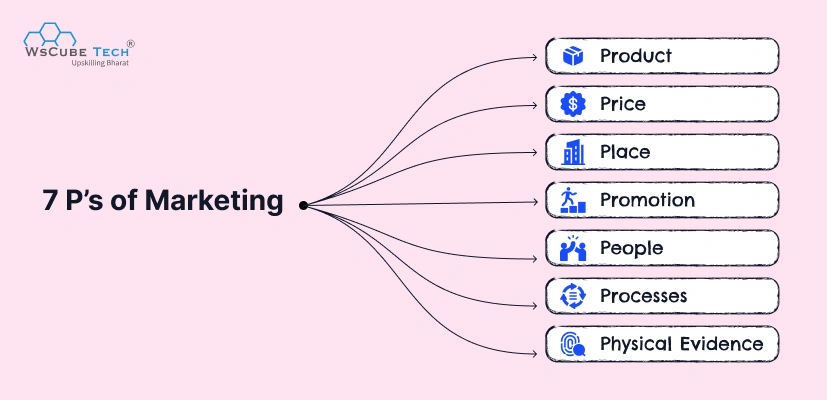Ever wondered why brands like McDonald’s, Apple, or Coca-Cola are recognized and loved everywhere? It’s because they master not just one aspect of marketing but all of them together: product, pricing, promotion, people, and more. These combined elements form what is known as the marketing mix.
Earlier, marketers followed only the 4 Ps of marketing mix, which included Product, Price, Place, and Promotion. Over time, three more were added: People, Process, and Physical Evidence. Together they form the 7 Ps of Marketing, a proven framework to plan, execute, and measure any business strategy.
Let’s understand the 7 Ps of marketing mix in simple terms with examples you can relate to.
What Are the 7 P’s in Marketing?
The 7 Ps of Marketing are seven key elements that help a company meet customer needs and build long-term satisfaction.
These are:
| Element | Meaning | |
| 1 | Product | What you sell |
| 2 | Price | What customers pay |
| 3 | Place | Where customers find it |
| 4 | Promotion | How people learn about it |
| 5 | People | Everyone involved in delivering it |
| 6 | Process | How it’s delivered efficiently |
| 7 | Physical Evidence | Tangible proof of your service |

7 P’s of Marketing
Let’s discuss in detail the 7 P’s of marketing with examples:
1. Product
Your product is the heart of the marketing mix. It can be a physical item, a digital service, or even an experience. The product must meet customer needs, solve a problem, and stand out from competitors.
When defining a product, marketers consider features, quality, design, packaging, and branding. Continuous improvement and innovation keep customers loyal.
Example:
Apple focuses on sleek design, powerful performance, and innovation in every iPhone. Each new model not only meets but exceeds customer expectations. That’s strong product marketing in action.
2. Price
Price is what a customer pays for the product or service. It directly affects sales, profits, and brand perception. Setting the right price means balancing affordability for customers and profitability for the business.
Marketers use various pricing strategies such as:
- Penetration pricing – setting a low price to attract new buyers.
- Skimming pricing – starting high, then lowering gradually.
- Competitive pricing – matching or beating market rates.
Example:
Netflix uses a tier-based pricing model, offering different subscription plans so every audience segment finds a comfortable price. This flexibility is a smart example of price mix.
Also Read: Future of Digital Marketing: Industry Trends 2025 and Beyond
3. Place
Place is about where and how your product reaches customers. The goal is to make it easily available when and where people want it. This includes choosing distribution channels like retail stores, e-commerce sites, or direct delivery.
Example:
Amazon perfected the “place” element by offering products online, delivering them quickly worldwide, and even using local warehouses for faster shipping.
Good placement ensures convenience and accessibility; two factors that strongly influence buying decisions.
4. Promotion
Promotion refers to all the methods used to communicate with potential customers and persuade them to buy. This includes advertising, PR campaigns, social media marketing, influencer partnerships, and discounts.
The main purpose is to create awareness, build trust, and drive sales. Successful promotion speaks directly to customer emotions and needs.
Example:
Coca-Cola’s “Share a Coke” campaign encouraged people to find bottles with their names, which is a personal, emotional, and memorable promotional idea that boosted sales globally.
5. People
The People element includes everyone involved in your brand, like employees, customer support, and even brand ambassadors. In service industries, people make or break the customer experience. Training, communication skills, and positive attitude matter the most.
Example:
Starbucks trains its staff to greet customers warmly, remember their preferences, and maintain consistency across stores. This people-first approach creates loyalty beyond the coffee itself.
Read More Marketing Guides
6. Process
Process is the step-by-step system that delivers your product or service to customers smoothly. It covers everything from ordering and payment to delivery and after-sales support. Efficient processes improve satisfaction and save time.
Example:
Domino’s has a well-structured process, from taking orders to 30-minute delivery, that ensures customers receive hot pizzas on time. This reliability strengthens its brand promise.
7. Physical Evidence
Physical Evidence includes all the tangible and visible cues that reassure customers of your brand’s credibility. It’s crucial in service marketing, where customers can’t “see” the service before buying.
Examples include store design, packaging, logos, website design, and even staff uniforms. These small details create trust and recognition.
Example:
When you enter a luxury hotel, the clean interiors, uniforms, and décor serve as physical evidence of quality service, even before you interact with anyone.
Also Read: Digital Marketing ROI: Meaning, Metrics, & How to Measure It
Importance of 7 P’s of Marketing Mix
Understanding and applying the 7 Ps of the marketing mix helps businesses:
- Deliver consistent customer experiences
- Build stronger brand identity and trust
- Improve product positioning and value perception
- Identify growth opportunities
- Optimize pricing and promotions for better ROI
- Align internal teams toward common goals
7 P’s of Marketing Example — McDonald’s
| P | How McDonald’s Applies It |
| Product | Wide variety – burgers, fries, beverages, desserts. |
| Price | Value meals and combo offers to attract all budgets. |
| Place | Global presence with outlets in over 100 countries. |
| Promotion | TV ads, digital marketing, and influencer tie-ups. |
| People | Trained staff ensuring fast, friendly service. |
| Process | Quick service systems and consistent quality worldwide. |
| Physical Evidence | Distinctive yellow-red branding and uniform interiors. |
McDonald’s success shows how mastering all 7 P’s of marketing mix ensures brand consistency everywhere.
How to Use 7 P’s of Marketing in Your Growt Strategy?
Using the 7 Ps of marketing mix is all about reviewing and improving each element to align with customer expectations and business goals. Below is how you can apply them step by step:
1. Analyze Your Product
Check if your product truly solves customer problems and meets current market demand. Improve features, packaging, or variants based on feedback.
2. Adjust Your Pricing Strategy
Research your competitors and decide whether to position your product as affordable, premium, or mid-range. Keep testing prices to find what converts best.
3. Choose the Right Place
Decide the best way to reach your audience, through online stores, retail outlets, or direct distribution. Convenience plays a key role in sales success.
4. Plan Effective Promotions
Use multiple promotion channels, like Google Ads, influencer marketing, or seasonal discounts, to increase visibility and attract customers.
5. Train and Empower People
Ensure your team understands your brand’s values and maintains consistent service quality. Motivated employees improve customer satisfaction naturally.
6. Streamline Your Process
Look for ways to make the buying journey faster and simpler, from easy checkout systems to smooth delivery or support processes.
7. Strengthen Physical Evidence
Present your brand professionally with a strong visual identity, through packaging, website design, and store interiors that reflect quality.
Common Mistakes Businesses Make with 7 P’s of Marketing
- Ignoring customer feedback while developing the product
- Setting unrealistic prices without market research
- Inconsistent branding or promotional messages
- Untrained staff damaging customer experience
- Poor processes causing delays or dissatisfaction

FAQs About 7 P’s for Marketing
The 4 Ps were introduced by E. Jerome McCarthy; later, Booms and Bitner added three more to create the 7 Ps model for services marketing.
The 4 Ps cover only Product, Price, Place, and Promotion; the 7 Ps add People, Process, and Physical Evidence for service-based industries.
All 7 work together, but Product remains the foundation, because without a valuable product, no marketing can succeed.
Yes. In digital spaces, these elements guide website design, pricing models, online ads, and customer experience.
It involves analyzing market needs, planning strategy using the 7 Ps, executing campaigns, and reviewing outcomes.
They provide a structured approach to improving customer satisfaction, optimizing profits, and sustaining long-term brand success.
Explore Our Free Courses


